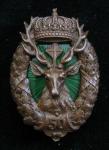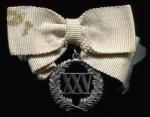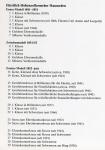-
Posts
1,291 -
Joined
-
Last visited
-
Days Won
20
Content Type
Profiles
Forums
Blogs
Gallery
Events
Store
Everything posted by Komtur
-
That´s odd indeed . To come back to my question above: also if it is not the decoration of colonel Waller, an order numbered C134 should be awarded in the early 20th century? Regards, Komtur.
-
That´s great ! I am sure it was his decoration. Searching on Google there is an information of his medal group sold by Emedals/Canada. Unfortunately I am not able to open www.emedals.ca . May be, his group is there still to be seen, they often not delete sold items. I got the single CVO from a German dealer. Regards, Komtur.
-
What period could this CVO be? I suppose early 20th century, if they count continuously? Regards, Komtur.
-
I would like to know, if there are modern copies of the commander of the Victoria Order around? My special interest are German imperial decorations and unfortunately I know not much about British ones. Because I would like to buy such a commander cross I wonder, what is a fair price? Any help is appreciated! Thanks and regards, Komtur.
-
Hm, strange. The "award document" is also not the real thing. At the best it is an official emitted duplicate, but I can not remember seeing something in that way. Additionaly I didn´t like the lettering of the handwriting at all. The document is signed GKamitz, unfortunately his name was Graf Kanitz. Regards, Komtur.
-
The Prussian orders (Red Eagle Order, Crown Order, House Order of Hohezollern) without swords are no war decorations. Therfore you will find not many of these awarded in WW1, and then for civil reasons. The higher classes, like the Red Eagle Order 1st class was given to defined ranks. In these ranks (like General der Infanterie/Artillerie/Kavallerie or Minister of the state) the awarded persons were in the age between 50 and 60 years. After 1918 there were no more awards of Prussian Orders besides the inofficial House Orders of Hohenzollern, given by the Ex-Kaiser in Doorn. IMHO it is hard to believe, that in the 1940ies there was a real demand of replacements of a Red Eagle Order breaststar. It is more probable, that these productions were made because of other reasons. Regards, Komtur.
-
All HOH decorations produced for the Ex-Kaiser in Doorn were made by Godet. In 1930 there was a markable change in the style and quality of ALL classes. This I could show not only for the two examples above. The most possible reason is, that the former owners of the traditional Godet firm Godet & Sohn, Eugen and Jean Godet were forced to leave the company. They founded in 1930 the new company Gebr. Godet & Co. The business relation to the Kaiser was based on the personel contact to the Godet family. The new firm had the possibility to deliver decorations to Doorn, but they had no more tools, therefore they had to made new ones. That is IMHO the reason for the distinct difference in all classes of the HOH awarded after 1930. About these questions I held a lecture a few weeks ago in Altenburg on the last meeting of the Deutsche Gesellschaft für Ordenskunde (15. Phaleristik-Symposium des Wissenschaftlichen Beirates der DGO). Much more will be published in one of the next magazins Orden und Ehrenzeichen of our society. The type of HOH3 on the here discussed bar you will hardly find on a bar or group, wich is evidently awarded before 1930. Regards, Komtur.
-
As wrote before by SaschaW: 1.) The HOH3 is made definitively after 1930 2.) There is NO person to be found in the Königlich Preußischen Ordenslisten with a combination of EK21870w/HOH3/RAO3Kr/KO4EB. To prevent a discussion of a "lost" red cross on the KO4: there is also NO person to be found with the combination of these decorations with a KO4GK. Only because of these two points there is no chance for this bar to be an original one. Besides of this, there are some other reasons ... Regards, Komtur.
-

Dr. Philip Frank
Komtur replied to Komtur's topic in Great Britain: Research, Documentation & History
Hi Steen, many thanks for these usefull informations. Regards, Komtur. -
I am searching for the decorations of Philip Frank (Manchester 1830 - London 1913), 1854 Army Surgeon 91st Regt Argyll & Sutherland Highlanders, from 1858 80th South Staffordshire Regt., doctor of medizin, Berlin 1853, Fellow of the Royal Society of Physicians, London 1871. Any help is appreciated. Regards, Komtur.
-
In the model overview, the first (1841) medals (picture above) are No. 6 and 7. To make it more complicate, there is an "interim" model 1851/52, also with two medals (No11 and 12). I could not find a picture of this interim medal, but as it is described in Nimmergut Vol. 1, it must be the style of the later and well known medals with the date 1841, but with enamel in coat of arms and crown.
-
We all are a bit wrong My fault was, to write: "in 1852 the medals (silver and gold) were established". I should had wrote "in 1852 these medals (silver and gold) were established", because there were medals from the beginning in 1841, but these were complete different in style and without any date (see picture).
















